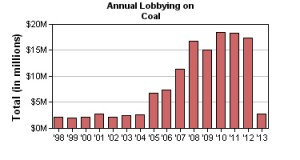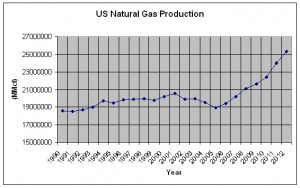 In spite of (or perhaps because of) all the recent chaos over embarrassing revelations of the surveillance habits of the US government, the Obama Administration pushed forward with its climate agenda last week and announced plans to further curb future carbon emissions. The plan, unveiled by the President during a speech at Georgetown University, called for the Environmental Protection Agency to establish more stringent carbon pollution standards for already active coal plants. As expected, the coal industry was quickly up in arms over the speech’s implications and moving forward with a massive, multi-million dollar public relations assault to counter the policy push by the Executive Branch. Of course, these types of PR expenditures by the coal industry have become increasingly commonplace as they enlist some friendly voices to push the narrative that the Obama Administration is actively trying to kill the coal industry.
In spite of (or perhaps because of) all the recent chaos over embarrassing revelations of the surveillance habits of the US government, the Obama Administration pushed forward with its climate agenda last week and announced plans to further curb future carbon emissions. The plan, unveiled by the President during a speech at Georgetown University, called for the Environmental Protection Agency to establish more stringent carbon pollution standards for already active coal plants. As expected, the coal industry was quickly up in arms over the speech’s implications and moving forward with a massive, multi-million dollar public relations assault to counter the policy push by the Executive Branch. Of course, these types of PR expenditures by the coal industry have become increasingly commonplace as they enlist some friendly voices to push the narrative that the Obama Administration is actively trying to kill the coal industry.
Coal can be a highly charged subject depending on which area of the country you live in and which party you tend to vote for. The argument for and against are generally framed in familiar fashion. On one side, we have the progressive, environmentalist argument—generally accompanied with images of billowing smoke stacks and/or the sad, soot smeared faces of coal workers—that, regardless of the general accessibility and its claims of being inexpensive, coal is incredibly harmful to the environment and people and should be held to a high regulatory standard if not eliminated altogether. On the other side of the coin, we have the conservative, economic angled argument—replete with images of smiling, relatively clean coal miners standing proudly outside a mine lift and/or pictures of happy families gathered closely together, bathing in the warm glow of inexpensive electricity provided by coal power—that coal is not as hazardous as many deem it to be. In addition, they point out that as of right now, it’s cheap and locally sourced which means it provides Americans with jobs and spurs growth for the American economy with dependable, inexpensive energy. Both sides, at times, make valid arguments. What can’t be argued is that the coal industry is spending a veritable mountain of cash to convince Congress and the American public that it is still a viable energy option but in the process is ignoring some painful truths.
Last year, the Coal Industry spent $17,361,948 on lobbying the Federal Government. (They also spent plenty of money lobbying various state governments as well, but that number is much more difficult to quantify.) In addition to pushing for favorable regulatory legislation, these lobbyists also work to make sure the subsidy spigot stays wide open.
Along with official lobbying, the Coal Industry also spent a considerable amount ($13,391,247) on political donations in the 2012 election cycle. One such recipient of this campaign cash is Republican Congressman David McKinley of West Virginia. McKinley receives the lion’s share of his campaign financing from the Mining industry—an amount more than any other member of Congress. Does this mean that Congressman McKinley owes an oath of fealty to the Coal Industry? Not necessarily. After all, as Mr. McKinley likes to point out, coal mining is one of West Virginia’s largest industries and provides jobs to his constituents. But it becomes rather apparent when Mr. McKinley introduces legislation like H.R.2273—a bill which, among other things, sought to prevent the EPA from designating coal ash (“Coal Combustion Residuals”) as hazardous—that the Coal Industry isn’t exactly throwing their money away when they write him checks. Sure, it can be argued that the Coal Industry provides jobs for West Virginians but outside of the strange semantic wonderland of a well lobbied Congress and the halls of the Coal Industry, nobody in their right mind is arguing that coal ash is not hazardous.
There is just way too much scientific evidence that confirms that coal ash is indeed hazardous. Not to mention, the recent instances of real world destruction that should lay rest to any notion that coal ash is some benign externality of necessary economic progress. Plainly stated, coal particulates are extremely hazardous and harmful, there’s just no way around it. Mitt Romney knew it before it became politically expedient to say otherwise. And that’s the bottom line. The coal industry spends a lot of money to make it politically difficult to state an obvious truth.
Another plain truth that the coal industry can’t admit is this: it isn’t over-regulation or some deep grudge the Obama Administration has against it that is killing coal. It’s the market and the massive increase in Natural Gas production. Here is a chart showing the Coal Industry’s lobbying expenditures in recent years:
Interestingly, in 2005, the executives in the coal industry made a decision to increase their lobbying expenditures by quite a large margin. Why the sudden increase then? After all, in 2005, they had a coal-friendly president in the White House and Barack Obama had just come onto the national political scene as a junior Senator from Illinois and didn’t pose much of a threat to them yet. Likely, the Shale Gas revolution that kicked off in late 2005 has a lot more to do with it. See here:
(source data: US Energy Information Administration)
The correspondence between coal lobbying expenditures and natural gas production is a hard coincidence to shrug off. Why do they fail to mention this more often?
It’s more palatable to say that your industry is beleaguered by a spiteful administration with unreasonable regulatory standards than it is to say that your industry is taking a beating because it produces a more expensive product with more negative externalities than your competitors’.
Perhaps worst of all for the coal industry, the argument that it is a major jobs creator in the US is becoming increasingly more difficult to make. As of 2012, the coal industry employed a total of 87,520 people according to the Bureau of Labor Statistics; a number that is only impressive without proper context. When compared to other industries, the number becomes rather paltry. The automotive industry, for instance, employs nearly ten times as many people. The Natural Gas Industry, coal’s closest competitor, employs 106,770. Even wind energy clocks in at a relatively formidable 85K employed.
This isn’t to trivialize the number of jobs created by the industry or the plight of the common coal worker. That’s 87,520 people who rely on coal to put food on their table, a roof over their head, and in many cases pay for the needs of their children. They are justifiably concerned about their future. But the writing is on the wall. The sun is setting on the coal industry, just as it did on the once gargantuan whaling industry a century and a half ago. And this isn’t a bad thing. Just like the coal industry, whaling also supported and fed families, but if we had allowed whaling to exist continuously on life support through legislative favors and lobbied subsidies solely for the sake of the employment of a relatively small segment of the population we might still be filling lanterns with whale oil or, most likely, long ago witnessed the self-imposed death of the industry after it had extinguished the whale species from the oceans entirely. Instead, thankfully, we found more efficient sources of the energy the country needed to expand and thrive. We’ll do it again. It looks like we already are.


Sorry, the comment form is closed at this time.